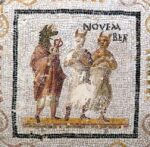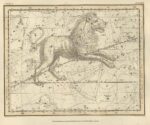Today is the first day of the River Houses homeschool year and the first day of our fall term: Cygnus Term, named for the Great Swan of the Heavens. Cygnus Term runs from September through November.
We put great stock in the educational value of the calendar in the River Houses. The calendar is the framework on which we human beings hang most of the facts we know about the world: historical events, natural phenomena, personal reminiscences, the seasons, blooming flowers, migrating birds, the sun and moon, the planets, the stars. A key part of every student’s intellectual development is the development of “calendar sense” — a sense of time and history.
![[Cygnus Constellation Chart (1822)]](https://riverhouses.org/wp-content/uploads/2022/02/cygnus-jamieson-1822.jpg)
Our annual River Houses calendar divides the homeschool year into four three-month terms (quarters) that correspond to the “meteorological seasons,” and these terms are named after prominent seasonal constellations of the northern hemisphere:
- 🗓 🦢 Fall or Cygnus Term (September–November)
- 🗓 🗡 Winter or Orion Term (December–February)
- 🗓 🦁 Spring or Leo Term (March–May)
- 🗓 💪 Summer or Hercules Term (June–August)
This calendrical division is an open-ended system that we’ve developed for the River Houses, and we think has a great deal of educational potential.
![[Cygnus Term]](https://riverhouses.org/wp-content/uploads/2024/09/cygnus-2024-1024x321.png)
As you think about your own homeschool year, think about how different parts of it — curricular, co-curricular, social, or recreational — can be informally arranged into these four terms. You could have a different decorating theme in your classroom each term, for example, or you could schedule a regular trip to a special place where you take a photo at the beginning of each term to track how the seasons change. You could group your curricular work by term, or bake a quarterly cake, or set goals at the beginning of each term that you want your students to have met by the end. You could have your students measure their height at the beginning of each term, or take their penny-jar to the bank for a quarterly deposit. At the end of each term you could assemble a portfolio of student accomplishments. With a little imagination you will be able to come up with a clever and comfortable arrangement and a new way to think about the structure of your educational year. (And you can use our simple planners to document your progress.)
![[Cygnus Constellation Chart]](https://riverhouses.org/wp-content/uploads/2022/09/cygnus-chart-term.png)
Cygnus Term is named for the Great Swan of the Heavens that is high in the east at sunset now each evening, and that will be passing overhead to the west as the fall comes on. (Your students’ vocabulary word for the day is “cygnet.” And be sure to take note of the scientific names of the earthly swans on page 22 in your bird guide.) Cygnus Term is home to Labor Day (2 September), Constitution Day and Citizenship Day (17 September), and the Autumnal Equinox (22 September); to Columbus Day (14 October) and the anniversary of the Battle of Hastings (also 14 October), to St. Crispin’s Day (25 October) and Halloween (31 October); to Marie Curie’s Birthday (7 November), Veterans Day (11 November), the annual Leonid Meteor Shower (16–18 November), and Thanksgiving (28 November) — not to mention countless other holidays, anniversaries, and events, local and global, public and private, that you may wish to mark on your own homeschool calendar.
If you want to make a special astronomical study this Cygnus Term, your River Houses reference library includes an excellent backyard guide to the night sky that will show you the location of Cygnus and its most prominent stars:
Cygnus lies in what for observers is a dense and fascinating part of the sky. The bird’s wings span the Milky Way at a location packed with stars and an assortment of deep-sky objects. Owing to the positions of its brightest stars it is sometimes called the Northern Cross — the northern parallel to the Southern Cross constellation in the Southern Hemisphere. You will see Cygnus highest in the sky in late summer and early fall, with its head pointing south like a bird on its migratory path toward warmer climates.
A thick band of dust lies within Cygnus, creating a dark space in the Milky Way that is easily visible to the naked eye under good conditions. This part of the Milky Way is known as the Cygnus Rift or the Northern Coalsack, a name borrowed from a similar dark spot found in the Southern Cross. (National Geographic Backyard Guide to the Night Sky, page 216)
Why not spend a little time out after dark with your students over the next three months and watch the Great Swan as he makes his nightly passage to the west. Once you learn to spot him, you’ll have a friend for life.
What educational adventures do you and your homescholars have planned for this year’s wonderful Cygnus Term? 😊
❡ Quarter days and cross-quarter days: Dividing the year into quarters is an ancient and natural practice: the annual movement of the sun across the sky automatically gives us two equinoxes, two solstices, and four seasons. Our four terms are just a simple modification of that arrangement so that our River Houses calendar will align more conveniently with the “meteorological seasons” (rather than the astronomical seasons) and also with the customary American school year. In many traditional calendrical systems, going back into the Middle Ages, the first day of each quarter is called the quarter day and the midpoint of each quarter is called the cross-quarter day. That means the quarter days of the River Houses year are 1 September, 1 December, 1 March, and 1 June, and the cross-quarter days are 16 October, 14 January (15 January in Leap Years), 15 April, and 16 July. (Fun fact: a vestige of the old system of quarter and cross-quarter days is Groundhog Day, also known as Candlemas on the Christian calendar: it’s the cross-quarter day between the winter solstice and the spring equinox.) Quarter days have for centuries been the traditional days on which school terms began, so homeschoolers who follow our four-term River Houses calendar are participating in a very ancient tradition indeed. 🦢 🗡 🦁 💪
❡ Watchers of the skies: Teaching your students to recognize the constellations is one of the simplest and most enduring gifts you can give them. Your recommended River Houses night-sky guide has descriptions and maps of each constellation that point out the highlights, and the astronomical section of your recommended world atlas has beautiful large charts of both celestial hemispheres. Why not find a dark-sky spot near you this term and spend some quality homeschool time beneath the starry vault. 🔭
❡ Choose something like a star: If you’d like some more light and easy homeschool astronomy lessons, download and print a copy of our annual River Houses Stars & Constellations Calendar and follow along with us month by month as we make twelve heavenly friends-for-life over the course of the year. 🌟
❡ Here, said the year: This is one of our regular posts about the seasons, months, and terms that make up the River Houses Homeschool Year. Add your name to our free mailing list to get more great homeschool teaching ideas delivered right to your mailbox every week. 📫
❡ Homeschool calendars: We have a whole collection of free, printable, educational homeschool calendars and planners available on our main River Houses calendar page. They will help you create a light and easy structure for your homeschool year. Give them a try today! 🗓
❡ Support our work: If you enjoy our educational materials, please support us by starting your regular Amazon shopping from our very own homeschool teaching supplies page. When you click through from our page, any purchase you make earns us a small commission at no extra cost to you. Thank you for helping us to keep going and growing! 🛒
❡ Join us! The aim of the River Houses project is to create a network of friendly local homeschool support groups — local chapters that we call “Houses.” Our first at-large chapter, Headwaters House, is now forming and is open to homeschoolers everywhere. Find out how to become one of our founding members on the Headwaters House membership page. 🏡




